There are as many ways and reasons to design a garden as their are gardeners — but Im with Billie. Its all about the feet (and paws).
I love to play with the varying scale that moving through a garden affords — plants experienced ankle-high, hip-high, the landscape pressing in, opening up, receding in the distance. I know a lot of gardens love the throw rug of a central lawn upon which to view the surrounding plants, where you can spin and turn in deciding which direction to explore. Openness, choice. But for whatever reason, Im bonded to the insistent journey of paths. If I had to guess the origin of my affinity for plant-lined paths, it likely stems from the lush growth the winter rains brought in spring to the empty fields near my Los Angeles home, and the paths the neighborhood kids blazed through the tall grass and mustard, the hidden forts we built — all of it lasting at most two months, before summer heat and drought burned it all away.
Im never quite happy with the movement through this small, plant-obsessed garden, no doubt the reason I change it up constantly. Today Im fighting an impulse to take out the middle of the garden and carve a path from the pergola to the back fence. I want a strolling, immersive garden this August, not a central garden filled with plants ringed in perimeter paths. (And less ambitiously, I also want the punctuation on my keyboard to function properly — apostrophes disappeared this morning as well as questions marks. Lets check out exclamation points — aha!)
In this fantasy, the miscanthus and justicia would remain, but Id have to pull out the central, very dark Phormium ‘Black Rage,’ one of the best Ive grown, the Roldana petasites, a young Rhodocoma capensis, kangaroo paws, emptying the giants out of the center and rebuilding it with low-growing aromatics, sculptural and swaying things too. (Also in this fantasy, I am not a rabid experimenter with new plants.) But all fantasies aside, in reality it would be a very short, silly path from pergola to the back fence. Better to have a long path meander east to west in this narrow rectangle, and that would mean a wholesale changeup, risking mature plants like Leucadendron Ebony (which from this view is mostly concealed by the phormium). Way back in the 90s, the garden did have a path that ran east to west, dry-laid brick on sand, but I gradually pulled it up to make room for more plants like the phormium…no doubt changes undertaken in August. This month always brings the change-it-up fidgets, a desire for new paths, new ways to experience the plants, new perspectives.
Try to imagine a little bungalow in place of this Tuscan villa — try hard and dont laugh — so the back of my house is on the left, the creeping-fig covered boundary wall on the right. That distant tree on the right is my fernleaf acacia. Looking out my office door east, I could make a walkable path through the center of the garden. It would mean massive amounts of replanting, but it is technically doable…
If I ran a path east-west again, some of the sesleria would have to be moved, but grasses are very accommodating to change-up whims. Ive given an overly large share of ground in this small garden to seslerias but dont regret this bargain. I could struggle with keeping something watered for months or have these oatsy, light-catching blades and flowers. And I love how a manihot aka hardy tapioca has found a way through.
And its not like I dont move plants all the time anyway. I love this part of making a garden. I moved a couple clumps of Carex testacea on Friday — the big fibrous rootballs really hold together when transplanted, so theres a good chance for success, even when doing this in August.
Two big clumps of Carex testacea were moved from the rock spine planting, one coming from the left of the restio. The chartreuse clump is Carex Everillo, a very promising sedge that tolerates more sun than I anticipated. I had planted five in deep shade in spring and noticed the clump in the most sun was by far the strongest in color and size, so a couple were moved to almost full-day sun here, just missing strong afternoon sun.
The other clump of Carex testacea was smothering my Aloe wickensii. Now the aloe just has to contend with Carex Feather Falls — another sedge new to me this year that is simply fabulous. I can see this sedge spilling onto my new east-west path.
More plant moves, but no new paths yet. A very large Silver Teaspoons kalanchoe was removed last week, maybe 3X3 feet in size with regular clipping. Winter blooming, adored by hummingbirds, the kalanchoe was an easy, invaluable place holder, protecting Leucadendron Jester while it deliberated whether to thrive or fail. With the leucadendron seemingly choosing to thrive, I began to contemplate removing the kalanchoe, first trying to prune it back to see if that helped the flow in this corner. After removing the old sideritis nearby of a similar size, the kalanchoe looked even more awkward. Is there a feng shui for gardens, question mark…because a perceived lack of flow really bugs me now, and I hate having to look over and around one plant to see another. Instead Im envisioning a long east-west path, each plant luminously outlined in the morning sun. Ah, the August fidgets strike again! But of course August is not the month for such garden upheaval in zone 10b, which is better scheduled for autumn — a delay that will help cool down and refocus the mad, impulsive fidgets of August.



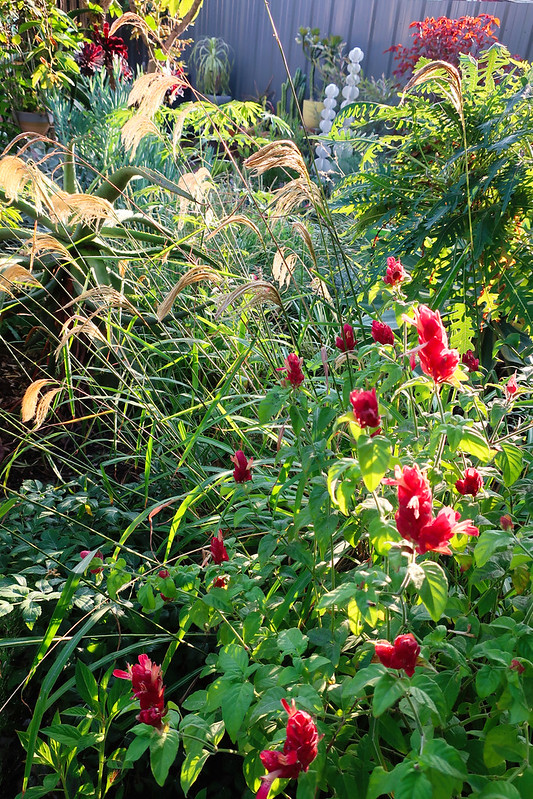
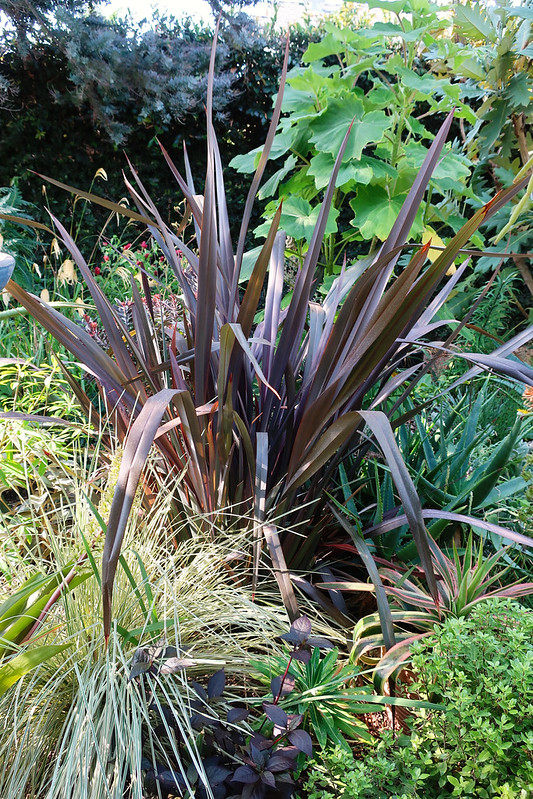
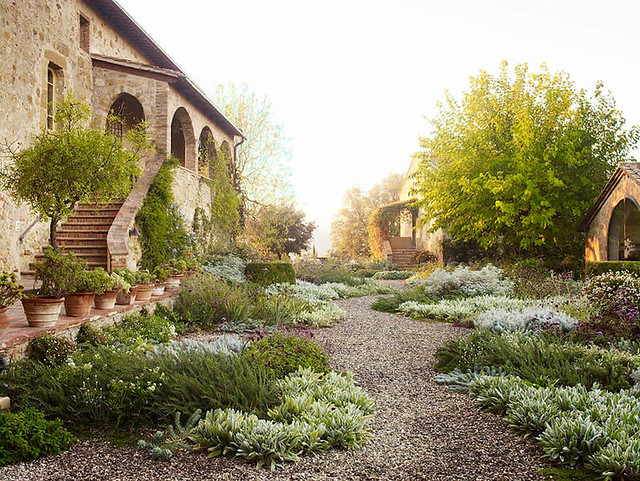

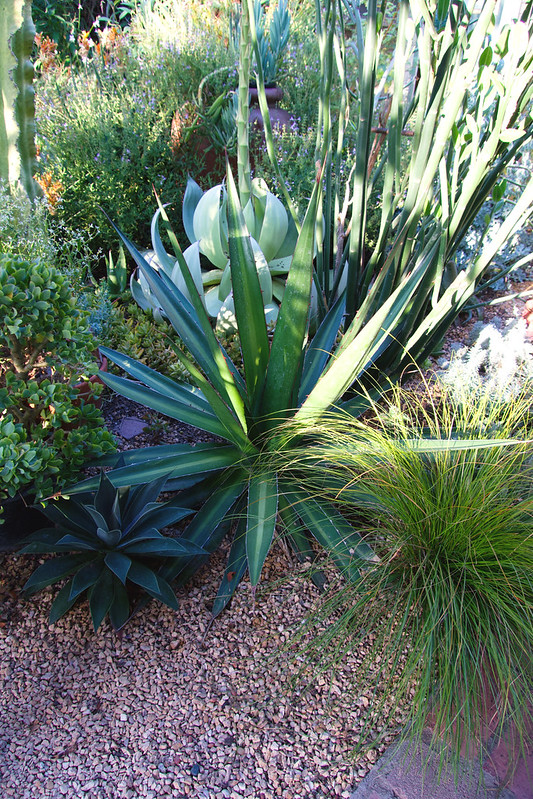
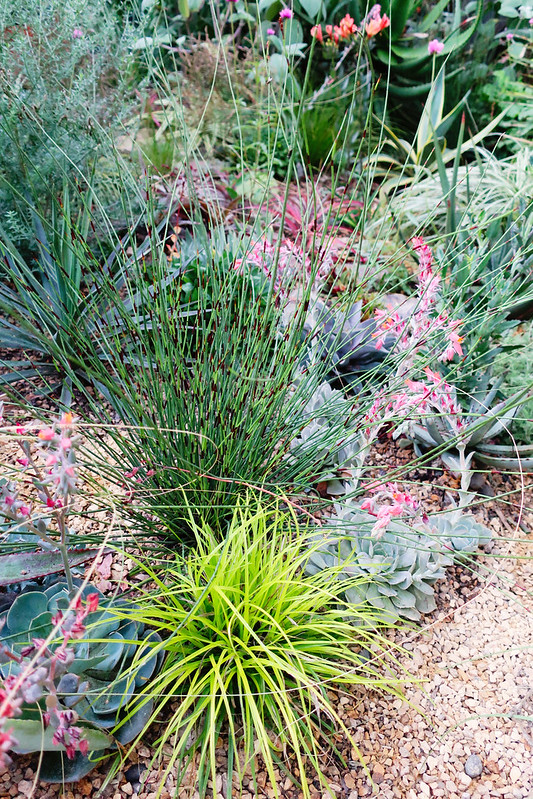

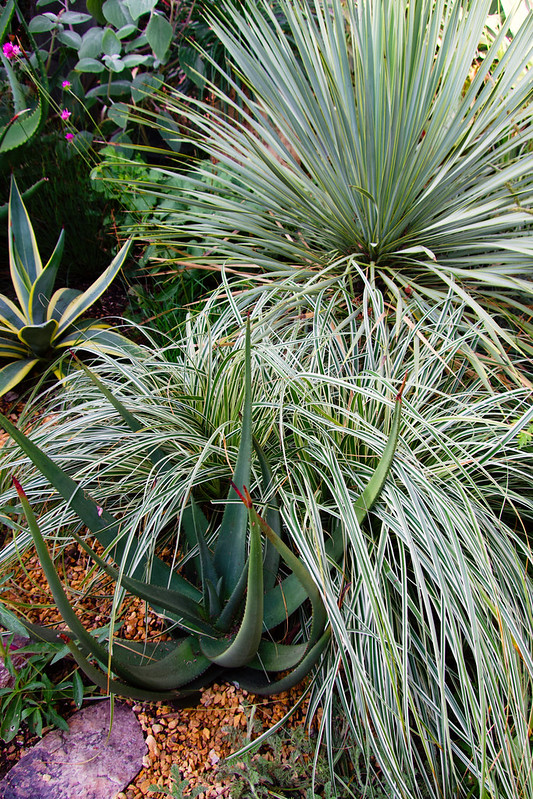


I know exactly what you mean. I love meandering paths, with plants politely saying hi on all sides without totally obscuring the walkways.
And like you, I get fidgety at this of year, except it’s too hot here in the Sacramento Valley to do much planting, let alone TRANSplanting.
Can’t wait to see what you do next. As for me, I’ll look for some seslerias!
It’s good to take time to deliberate while you wait for cooler temperatures to gain a foothold. I’m reminded how much easier it is to plant a blank slate than to renovate an existing landscape filled with plants you love, which just might be in the wrong place. I’m in the mood to pull part and replant the whole middle section of my backyard but (luckily or not) much of that area is occupied by rhizomatous plants that I’m not especially fond of, although removing those will ultimately impact plants I’d like to keep too.
Oh yes, dissatisfaction with my garden is at it’s height in August and momentous decisions are often made. I have many plans for fall.
I’m so enjoying meandering through your garden and am reminded by the comments that it’s always an ongoing process and we are never quite satisfied. I’m in NJ and brought back a tiny Crape Myrtle, that I forced my friend, to stuff in her back seat. No easy feat. At any rate the poor thing has struggled for years, but I didn’t have the heart to take it out. Long story short, after at least 10 yrs. it is now quite beautiful and finally blooming…Plants are fickle and have minds of their own.
The fidgets must come in August because we are on the cusp of a new season. I love full gardens where you have to push your way through the plants. It’s very immersive. However, by August when things are just a little ‘too wild’ it’s time to exert some control. Your Fall is like our Spring and has you raring to go to make changes. For what it’s worth I say go with it and have some fun.
@Gerhard, its been in the 80s here, not too hot to tackle a small project, and I didnt take out the phormium!
@Kris, reworking areas in my small garden is nothing like what you undertake in yours — that takes some careful planning, all those sightlines, etc.
@Kathy, do please post about your plans!
@Rebecca, Im so glad you commented, and congrats on sticking with the crepe myrtle! Gardens are a long game, which I was just thinking about today, how theres so much coverage of interior design vs. garden design — because 1) you have to hold on to the property while the garden grows and 2) it takes a while for the garden to grow! And 3) theres less interest in gardens than interior design, lets be honest…
@Elaine, yes exactly. And I took your advice and had some fun!
I’m impressed at other gardeners willing to do so much work to constantly update how they enjoy their gardens, but would never consider such in my own garden, the bones are not going to change. It did change dramatically once at middle age some 15 years ago when the central feature arching Japanese Plum festooned with hanging baskets and epiphytes finally keeled over, and it made little sense to preserve the now rotting raised deck below it.
Good luck sorting out which plants remain/get edited, but you seem quite confident in your willingness to do so continuously! I think having other, client’s gardens to evolve puts my own garden at less risk of changes; less pressure to pull/edit/replace out of a desire for the new; I mostly do so if plants die or fail to thrive. Sometimes it can take a decade to decide, I finally pulled a decrepit 10 years old Mimetes cucculatus that should have disappeared years ago, truth be told.